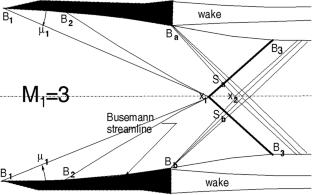独立式锥形震波
IF 1.7
4区 工程技术
Q3 MECHANICS
引用次数: 0
摘要
本文提供了布斯曼进气流中独立锥形激波和压缩共焦特征区存在的实验证据。采用Busemann环模型,在自由流马赫数为3.0的DRDC三声速风洞中进行了实验。将Taylor-McColl方程进行积分得到Busemann流线,从而得到Busemann环的内表面。采用局部自适应非结构化欧拉有限体积程序对流场进行CFD分析,结果与实验结果一致。本文章由计算机程序翻译,如有差异,请以英文原文为准。

Free-standing conical shock
In this paper, we provide the experimental evidence of a free-standing conical shock and the compressive confocal characteristics region in the Busemann intake flow. The experiments are carried out in the DRDC Trisonic Wind Tunnel at freestream Mach number 3.0 with a Busemann ring model. The Taylor-McColl equations are integrated to obtain the Busemann streamline and hence the inner surface of the Busemann ring. The CFD analysis of the flow using a locally adaptive unstructured Euler finite-volume code is in agreement with the experiments.
求助全文
通过发布文献求助,成功后即可免费获取论文全文。
去求助
来源期刊

Shock Waves
物理-力学
CiteScore
4.10
自引率
9.10%
发文量
41
审稿时长
17.4 months
期刊介绍:
Shock Waves provides a forum for presenting and discussing new results in all fields where shock and detonation phenomena play a role. The journal addresses physicists, engineers and applied mathematicians working on theoretical, experimental or numerical issues, including diagnostics and flow visualization.
The research fields considered include, but are not limited to, aero- and gas dynamics, acoustics, physical chemistry, condensed matter and plasmas, with applications encompassing materials sciences, space sciences, geosciences, life sciences and medicine.
Of particular interest are contributions which provide insights into fundamental aspects of the techniques that are relevant to more than one specific research community.
The journal publishes scholarly research papers, invited review articles and short notes, as well as comments on papers already published in this journal. Occasionally concise meeting reports of interest to the Shock Waves community are published.
 求助内容:
求助内容: 应助结果提醒方式:
应助结果提醒方式:


